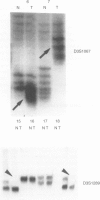Abstract
As chromosomes 2p and 3p are frequent targets for genomic instability in lung cancer, we have addressed whether alterations of simple (CA)n DNA repeats occur in non-small-cell lung cancer (NSCLC) at early stages. We have analysed by polymerase chain reaction (PCR) assay replication errors (RER) and loss of heterozygosity (LOH) at microsatellites mapped on chromosomes 2p and 3p in 64 paired tumour-normal DNA samples from consecutively resected stage I, II or IIIA NSCLC. DNA samples were also examined for K-ras and p53 gene mutations by PCR-single-stranded conformational polymorphism (PCR-SSCP) analysis and cyclic sequencing, as well as their relationship with clinical outcome. Forty-two of the 64 (66%) NSCLC patients showed RER at single or multiple loci. LOH was detected in 23 tumours (36%). Among patients with stage I disease, the 5-year survival rate was 80% in those whose tumours had no evidence of RER and 26% in those with RER (P = 0.005). No correlation was established between RER phenotype and LOH, K-ras or p53 mutations. RER remained a strong predictive factor (hazard ratio for death, 2.89; 95% confidence interval, 2.23-3.79; P = 0.002) after adjustment for all other evaluated factors, including p53, K-ras, LOH, histological type, tumour differentiation and TNM stage, suggesting that microsatellite instability on chromosomes 2p and 3p may play a role in NSCLC progression through a different pathway from the traditional tumour mechanisms of oncogene activation and/or tumour-suppressor gene inactivation.
Full text
PDF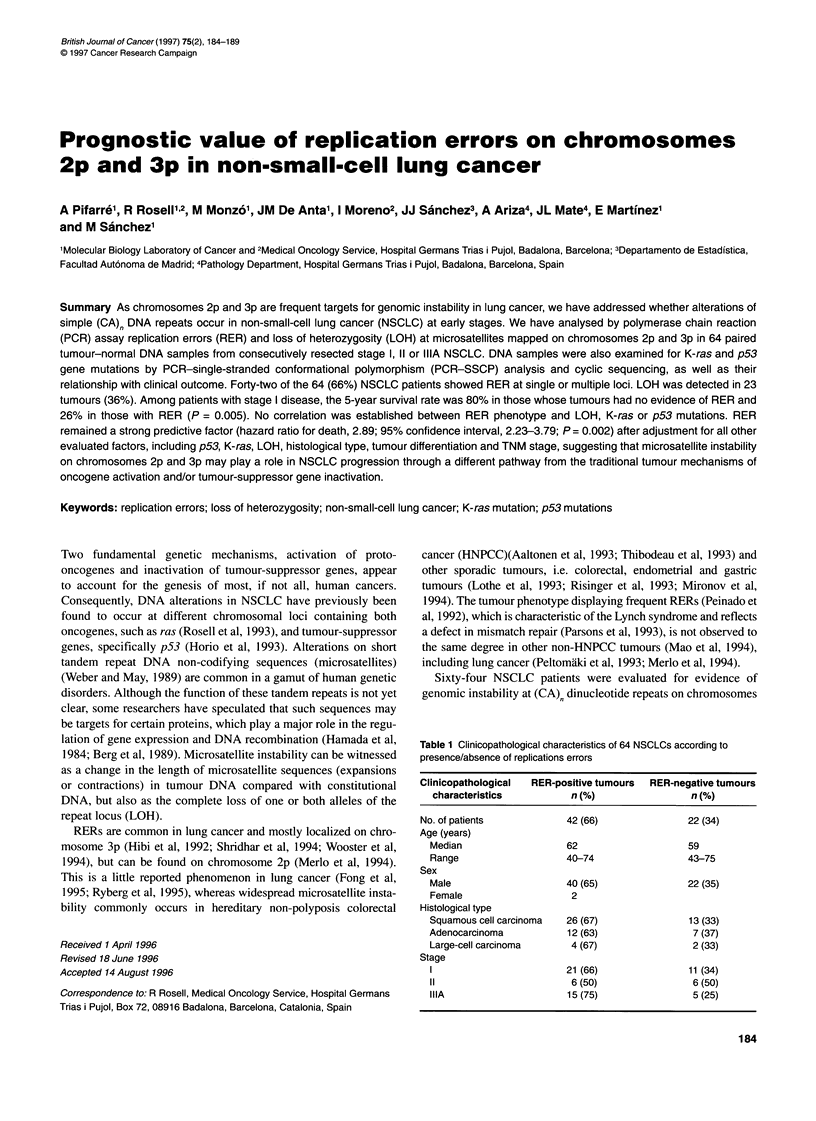
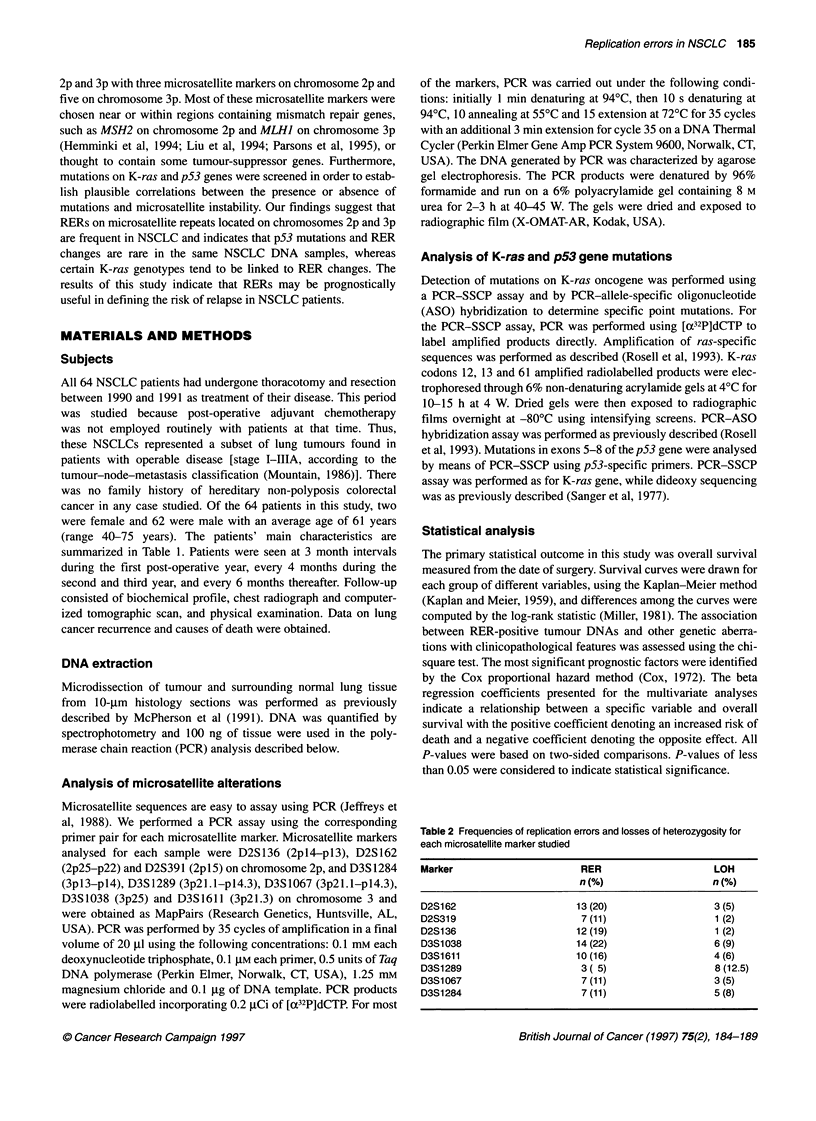
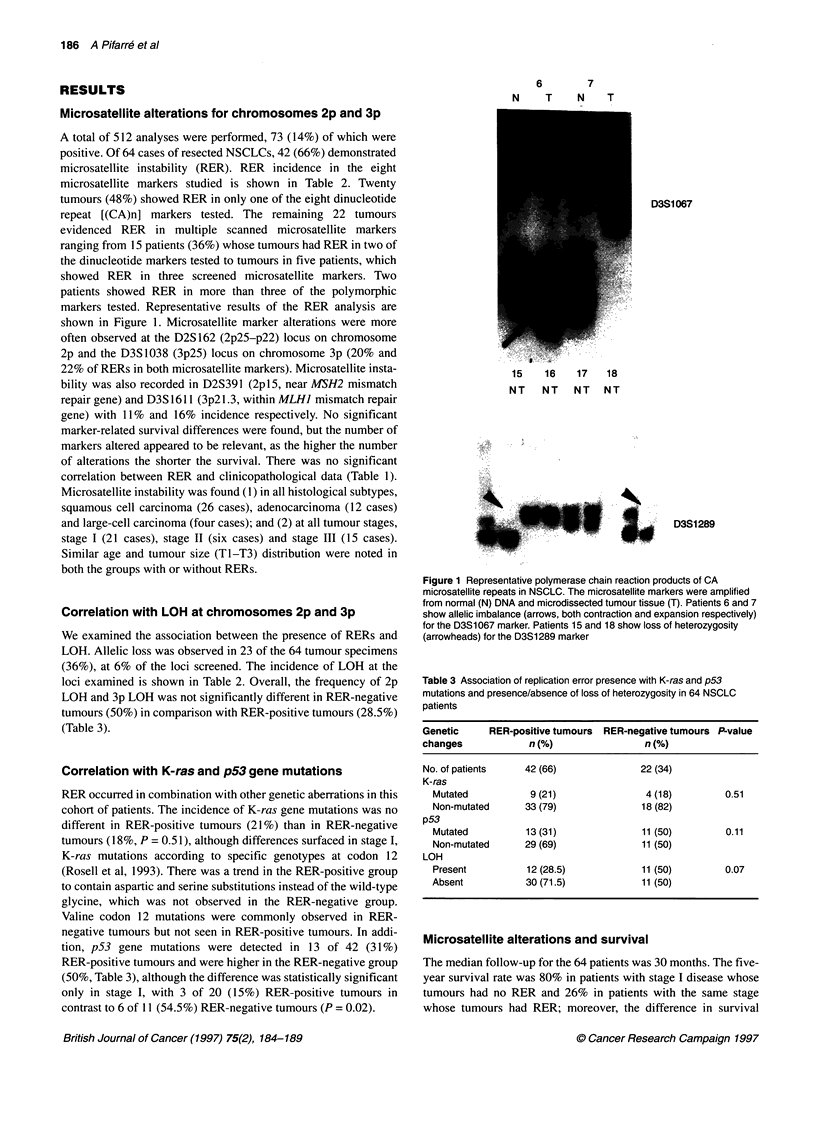
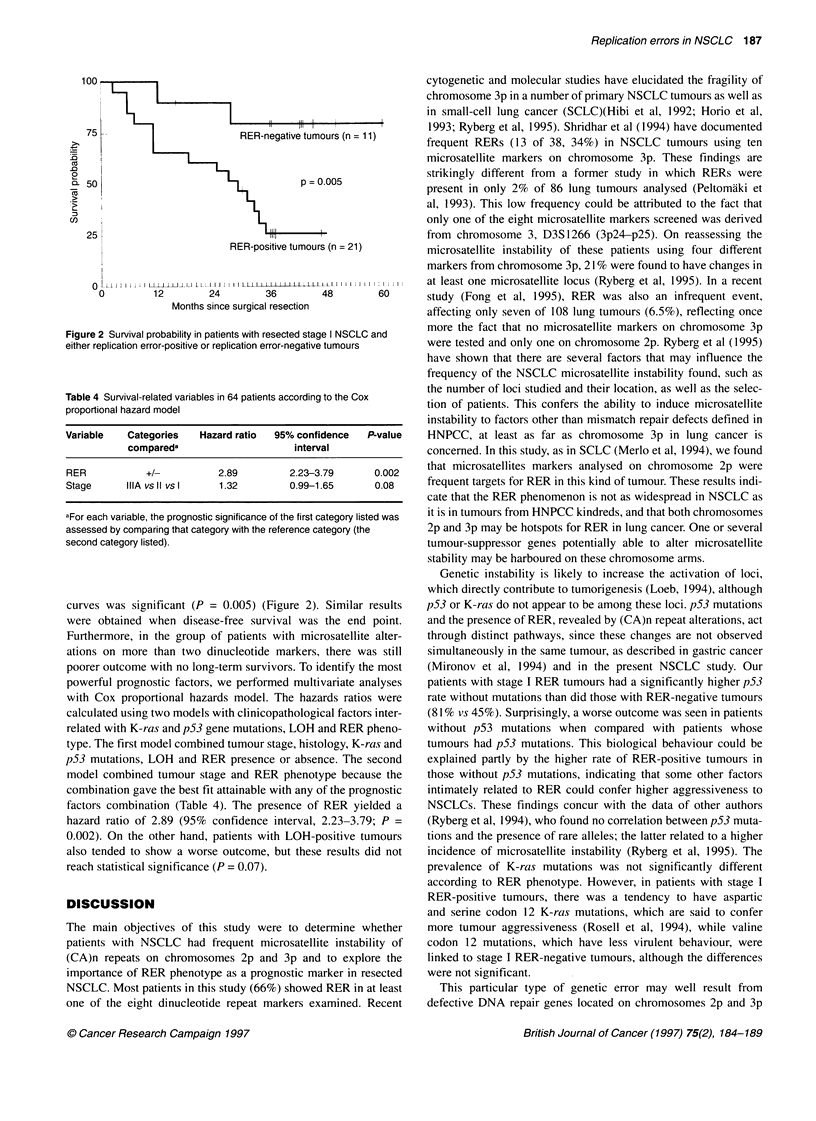
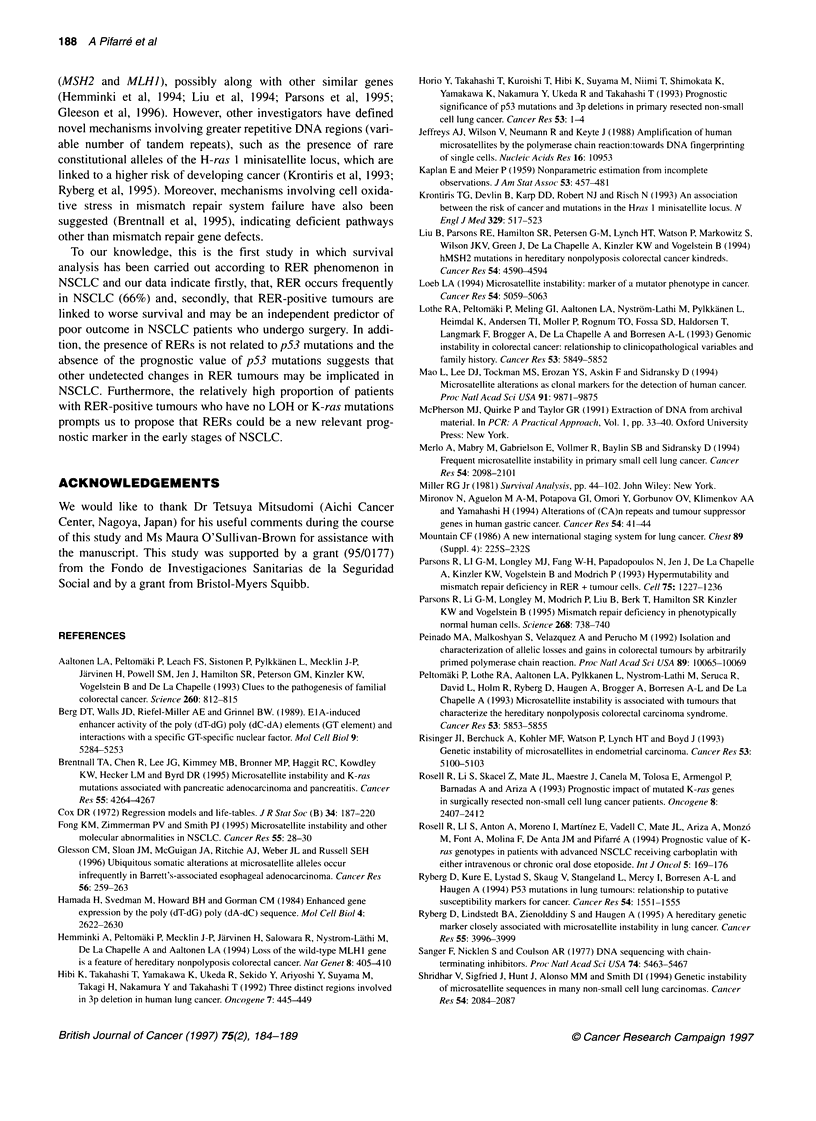

Images in this article
Selected References
These references are in PubMed. This may not be the complete list of references from this article.
- Aaltonen L. A., Peltomäki P., Leach F. S., Sistonen P., Pylkkänen L., Mecklin J. P., Järvinen H., Powell S. M., Jen J., Hamilton S. R. Clues to the pathogenesis of familial colorectal cancer. Science. 1993 May 7;260(5109):812–816. doi: 10.1126/science.8484121. [DOI] [PubMed] [Google Scholar]
- Berg D. T., Walls J. D., Reifel-Miller A. E., Grinnell B. W. E1A-induced enhancer activity of the poly(dG-dT).poly(dA-dC) element (GT element) and interactions with a GT-specific nuclear factor. Mol Cell Biol. 1989 Nov;9(11):5248–5253. doi: 10.1128/mcb.9.11.5248. [DOI] [PMC free article] [PubMed] [Google Scholar]
- Brentnall T. A., Chen R., Lee J. G., Kimmey M. B., Bronner M. P., Haggitt R. C., Kowdley K. V., Hecker L. M., Byrd D. R. Microsatellite instability and K-ras mutations associated with pancreatic adenocarcinoma and pancreatitis. Cancer Res. 1995 Oct 1;55(19):4264–4267. [PubMed] [Google Scholar]
- Fong K. M., Zimmerman P. V., Smith P. J. Microsatellite instability and other molecular abnormalities in non-small cell lung cancer. Cancer Res. 1995 Jan 1;55(1):28–30. [PubMed] [Google Scholar]
- Gleeson C. M., Sloan J. M., McGuigan J. A., Ritchie A. J., Weber J. L., Russell S. E. Ubiquitous somatic alterations at microsatellite alleles occur infrequently in Barrett's-associated esophageal adenocarcinoma. Cancer Res. 1996 Jan 15;56(2):259–263. [PubMed] [Google Scholar]
- Hamada H., Seidman M., Howard B. H., Gorman C. M. Enhanced gene expression by the poly(dT-dG).poly(dC-dA) sequence. Mol Cell Biol. 1984 Dec;4(12):2622–2630. doi: 10.1128/mcb.4.12.2622. [DOI] [PMC free article] [PubMed] [Google Scholar]
- Hemminki A., Peltomäki P., Mecklin J. P., Järvinen H., Salovaara R., Nyström-Lahti M., de la Chapelle A., Aaltonen L. A. Loss of the wild type MLH1 gene is a feature of hereditary nonpolyposis colorectal cancer. Nat Genet. 1994 Dec;8(4):405–410. doi: 10.1038/ng1294-405. [DOI] [PubMed] [Google Scholar]
- Hibi K., Takahashi T., Yamakawa K., Ueda R., Sekido Y., Ariyoshi Y., Suyama M., Takagi H., Nakamura Y., Takahashi T. Three distinct regions involved in 3p deletion in human lung cancer. Oncogene. 1992 Mar;7(3):445–449. [PubMed] [Google Scholar]
- Horio Y., Takahashi T., Kuroishi T., Hibi K., Suyama M., Niimi T., Shimokata K., Yamakawa K., Nakamura Y., Ueda R. Prognostic significance of p53 mutations and 3p deletions in primary resected non-small cell lung cancer. Cancer Res. 1993 Jan 1;53(1):1–4. [PubMed] [Google Scholar]
- Jeffreys A. J., Wilson V., Neumann R., Keyte J. Amplification of human minisatellites by the polymerase chain reaction: towards DNA fingerprinting of single cells. Nucleic Acids Res. 1988 Dec 9;16(23):10953–10971. doi: 10.1093/nar/16.23.10953. [DOI] [PMC free article] [PubMed] [Google Scholar]
- Krontiris T. G., Devlin B., Karp D. D., Robert N. J., Risch N. An association between the risk of cancer and mutations in the HRAS1 minisatellite locus. N Engl J Med. 1993 Aug 19;329(8):517–523. doi: 10.1056/NEJM199308193290801. [DOI] [PubMed] [Google Scholar]
- Liu B., Parsons R. E., Hamilton S. R., Petersen G. M., Lynch H. T., Watson P., Markowitz S., Willson J. K., Green J., de la Chapelle A. hMSH2 mutations in hereditary nonpolyposis colorectal cancer kindreds. Cancer Res. 1994 Sep 1;54(17):4590–4594. [PubMed] [Google Scholar]
- Loeb L. A. Microsatellite instability: marker of a mutator phenotype in cancer. Cancer Res. 1994 Oct 1;54(19):5059–5063. [PubMed] [Google Scholar]
- Lothe R. A., Peltomäki P., Meling G. I., Aaltonen L. A., Nyström-Lahti M., Pylkkänen L., Heimdal K., Andersen T. I., Møller P., Rognum T. O. Genomic instability in colorectal cancer: relationship to clinicopathological variables and family history. Cancer Res. 1993 Dec 15;53(24):5849–5852. [PubMed] [Google Scholar]
- Mao L., Lee D. J., Tockman M. S., Erozan Y. S., Askin F., Sidransky D. Microsatellite alterations as clonal markers for the detection of human cancer. Proc Natl Acad Sci U S A. 1994 Oct 11;91(21):9871–9875. doi: 10.1073/pnas.91.21.9871. [DOI] [PMC free article] [PubMed] [Google Scholar]
- Merlo A., Mabry M., Gabrielson E., Vollmer R., Baylin S. B., Sidransky D. Frequent microsatellite instability in primary small cell lung cancer. Cancer Res. 1994 Apr 15;54(8):2098–2101. [PubMed] [Google Scholar]
- Mironov N. M., Aguelon M. A., Potapova G. I., Omori Y., Gorbunov O. V., Klimenkov A. A., Yamasaki H. Alterations of (CA)n DNA repeats and tumor suppressor genes in human gastric cancer. Cancer Res. 1994 Jan 1;54(1):41–44. [PubMed] [Google Scholar]
- Mountain C. F. A new international staging system for lung cancer. Chest. 1986 Apr;89(4 Suppl):225S–233S. doi: 10.1378/chest.89.4_supplement.225s. [DOI] [PubMed] [Google Scholar]
- Parsons R., Li G. M., Longley M. J., Fang W. H., Papadopoulos N., Jen J., de la Chapelle A., Kinzler K. W., Vogelstein B., Modrich P. Hypermutability and mismatch repair deficiency in RER+ tumor cells. Cell. 1993 Dec 17;75(6):1227–1236. doi: 10.1016/0092-8674(93)90331-j. [DOI] [PubMed] [Google Scholar]
- Peinado M. A., Malkhosyan S., Velazquez A., Perucho M. Isolation and characterization of allelic losses and gains in colorectal tumors by arbitrarily primed polymerase chain reaction. Proc Natl Acad Sci U S A. 1992 Nov 1;89(21):10065–10069. doi: 10.1073/pnas.89.21.10065. [DOI] [PMC free article] [PubMed] [Google Scholar]
- Peltomäki P., Lothe R. A., Aaltonen L. A., Pylkkänen L., Nyström-Lahti M., Seruca R., David L., Holm R., Ryberg D., Haugen A. Microsatellite instability is associated with tumors that characterize the hereditary non-polyposis colorectal carcinoma syndrome. Cancer Res. 1993 Dec 15;53(24):5853–5855. [PubMed] [Google Scholar]
- Risinger J. I., Berchuck A., Kohler M. F., Watson P., Lynch H. T., Boyd J. Genetic instability of microsatellites in endometrial carcinoma. Cancer Res. 1993 Nov 1;53(21):5100–5103. [PubMed] [Google Scholar]
- Rosell R., Li S., Skacel Z., Mate J. L., Maestre J., Canela M., Tolosa E., Armengol P., Barnadas A., Ariza A. Prognostic impact of mutated K-ras gene in surgically resected non-small cell lung cancer patients. Oncogene. 1993 Sep;8(9):2407–2412. [PubMed] [Google Scholar]
- Ryberg D., Kure E., Lystad S., Skaug V., Stangeland L., Mercy I., Børresen A. L., Haugen A. p53 mutations in lung tumors: relationship to putative susceptibility markers for cancer. Cancer Res. 1994 Mar 15;54(6):1551–1555. [PubMed] [Google Scholar]
- Ryberg D., Lindstedt B. A., Zienolddiny S., Haugen A. A hereditary genetic marker closely associated with microsatellite instability in lung cancer. Cancer Res. 1995 Sep 15;55(18):3996–3999. [PubMed] [Google Scholar]
- Shridhar V., Siegfried J., Hunt J., del Mar Alonso M., Smith D. I. Genetic instability of microsatellite sequences in many non-small cell lung carcinomas. Cancer Res. 1994 Apr 15;54(8):2084–2087. [PubMed] [Google Scholar]
- Thibodeau S. N., Bren G., Schaid D. Microsatellite instability in cancer of the proximal colon. Science. 1993 May 7;260(5109):816–819. doi: 10.1126/science.8484122. [DOI] [PubMed] [Google Scholar]
- Weber J. L., May P. E. Abundant class of human DNA polymorphisms which can be typed using the polymerase chain reaction. Am J Hum Genet. 1989 Mar;44(3):388–396. [PMC free article] [PubMed] [Google Scholar]
- Wooster R., Cleton-Jansen A. M., Collins N., Mangion J., Cornelis R. S., Cooper C. S., Gusterson B. A., Ponder B. A., von Deimling A., Wiestler O. D. Instability of short tandem repeats (microsatellites) in human cancers. Nat Genet. 1994 Feb;6(2):152–156. doi: 10.1038/ng0294-152. [DOI] [PubMed] [Google Scholar]



